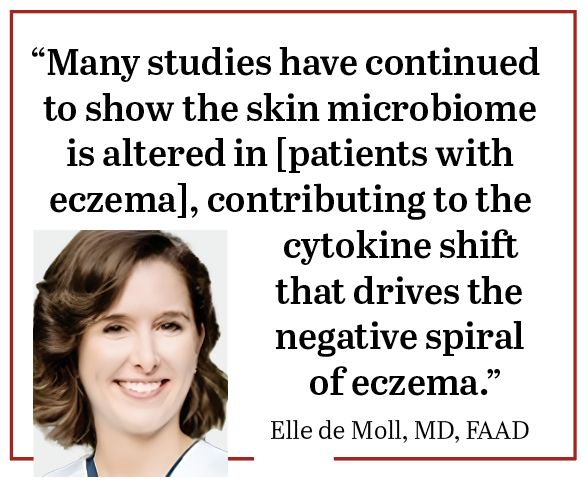The critical role of the gut microbiota in the development of atopic dermatitis (AD) has received attention in recent years, and October marks National Eczema Awareness Month. The impact begins in utero, with the diet and health of the mother playing a key role in the potential for a child to develop diseases. Recent research suggests that microbes in the vaginal tract interact with a developing fetus, which affects prenatal growth and pregnancy duration.1 A Western diet also has been linked to the development of some immune-mediated inflammatory diseases, such as AD.2
Early Life
In the Stool Microbiome and Allergic ReacTion (SMART) study in China, which observed the connection between the gut microbiome and development of AD, researchers identified the mode of delivery, feeding method, and intrapartum antibiotic use as major influencers of the early-life gut microbiome and suggested that alterations in the infant gut microbiota can precede development of AD.3
Many studies have shown that AD is related to gut dysbiosis, particularly early in life.4 Staphylococcus aureus, Clostridioides difficile, and Escherichia coli are associated with higher risk of developing AD.3,4 Certain species of bifidobacteria, such as Bifidobacterium catenulatum, Bifidobacterium bifidum, and Bifidobacterium pseudocatenulatum, are found in greater abundance in patients with AD.4 Conversely, short-chain fatty acids (SCFAs) are microbial metabolites with anti-inflammatory effects; high concentrations of SCFAs are related to decreased risk of developing AD.4
Key Takeaways
- The mode of delivery, feeding method, and antibiotic use during labor can significantly impact the early-life gut microbiome, which can precede the development of AD.
- Studies have consistently shown a link between gut dysbiosis, especially in early life, and AD.
- Short-chain fatty acids (SCFAs) with anti-inflammatory effects are associated with a decreased risk of developing AD.
- The mode of delivery (vaginal vs. cesarean) and feeding method (breastfeeding vs. formula) significantly affect the gut microbiota in a child's first year of life.
- Research suggests that an imbalance of the gut microbiome can increase inflammation in the body and exacerbate skin conditions like AD.
- Environmental factors, such as exposure to pollutants, dust, pollen, and climate, can exacerbate atopic dermatitis.
“When discussing the microbiome with someone who is expecting, it is essential to point out that it all stems from the gut, which has over a trillion microbiomes and over 1000 species,” said Renata Block, MMS, PA-C, a board-certified physician assistant at Advanced Dermatology & Aesthetic Medicine in Chicago, Illinois, and a Dermatology Times Editorial Advisory Board member.
In the SMART prospective cohort study, Cheung et al followed 112 Chinese children from birth to age 3 years, taking stool samples at 9 points to characterize the gut microbiome.3 The authors found that mode of delivery and feeding mode had a significant effect on the gut microbiota in a child’s first year of life. The gut microbiota of children born vaginally differed from those born by cesarean delivery, with children born vaginally showing a significantly higher concentration of the genus Bacteroides. At all 4 points throughout the first year, Bacteroides was significantly lower in children with AD.3
A review by Fang et al found that infants born vaginally had higher concentrations of Lactobacillus, Prevotella, and Sneathia spp. resembling their mother’s vaginal microbiota, but infants born by cesarean delivery had an abundance of Staphylococcus, Corynebacterium, and Propionibacterium spp., similar to the microbiota of skin.5
Infants who were exclusively breastfed displayed an abundance of different genera than infants exclusively fed formula. Treatment with intrapartum antibiotics also had an impact on the gut microbiota of infants.3
Probiotics for Treatment of AD
“Research has found having an imbalance of microbiome in the gut can increase inflammation in the body and exacerbate diseases such as acne, psoriasis, atopic dermatitis, and hidradenitis suppurativa,” Block said. “To maintain a healthy microbiome, eating foods rich in prebiotics and probiotics and avoiding harsh products that compromise the skin barrier should be a daily practice. Prebiotic foods include high-fiber foods such as bananas, soybeans, and artichokes, to name a few. These help feed the good microbiome in the gut. Probiotic foods like yogurts, kefir, and kombucha replace the good bacteria lost in the gut from inflammation, stress, antibiotics, or other factors.”
Given the impact of microbes on the gut microbiome, much research has been conducted on the effect of taking probiotics to support a healthy gut. Gut microbiota and microbial metabolites show promise as therapies for treating AD by restoring the balance of the gut ecology. Much of the research has focused on Lactobacilli and Bifidobacteria, which support the production of IL-10 and compete with pathogenic bacteria for nutrition and binding mucin.4 Studies have shown that early exposure to Lactobacillus rhamnosus reduces the incidence of AD during the first 4 years and possibly up to age 10 years.4
“According to a systemic review and meta-analysis published in Nutrients, ‘probiotic and prebiotic products are safe for use during pregnancy and lactation,’” Block said.5 “Before a pregnant patient begins supplements, however, they should clear the use with their clinician.”
The long-term use of probiotics can restore balance to the gut microbiota, alleviating the clinical manifestation of AD by affecting the gut’s microbial composition, metabolic functions, and immune responses. Probiotics support the synthesis of nutrients such as amino acids and vitamins and increase the content of SCFAs in the intestinal lumen.6
Pro-inflammatory cytokines such as IL-13, IL-5, and thymic stromal lymphopoietin can also be regulated by probiotics. Supplements offer promise as a treatment for the approximately 10% of the adult population with AD6 by altering the gut microbiome.
“The gut microbiome is a fascinating new area of interest in dermatology in general, but I think will be critical to our understanding of eczema. Many studies have continued to show the skin microbiome is altered in [patients with eczema], contributing to the cytokine shift that drives the negative spiral of eczema,” Elle de Moll, MD, FAAD, board-certified dermatologist at Dermatology Physicians of Connecticut, told Dermatology Times.
Environmental Factors
The type of environment in which a person lives can affect the gut microbiome. In one study, manipulating urban environmental biodiversity showed that the gut microbial diversity of children in a nature-oriented daycare environment was increased compared with children in an urban environment.6 The environment plays an important role in the development of AD, affecting the skin and gut microbiomes. “We know that atopic dermatitis, like any skin disease, is multifactorial and not only caused by genetics but also by a decreased barrier, gut dysbiosis, and, lastly, something known as the ‘envirome,’ which are environmental exposures. Exposure to pollutants and other environmental factors such as dust, pollen, [and] climate…can exacerbate atopic dermatitis,” Block said.
Many components influence the development of AD starting in utero and continuing throughout life. Dermatology clinicians can help patients of all ages by educating them about the gut microbiome and the role it plays in disease.
References
1. Robertson RC, Manges AR, Finlay BB, Prendergast AJ. The human microbiome and child growth - first 1000 days and beyond. Trends Microbiol. 2019;27(2):131-147. doi:10.1016/j.tim.2018.09.008
2. De Pessemier B, Grine L, Debaere M, Maes A, Paetzold B, Callewaert C. Gut-skin axis: current knowledge of the interrelationship between microbial dysbiosis and skin conditions. Microorganisms. 2021;9(2):353. doi:10.3390/microorganisms9020353
3. Cheung MK, Leung TF, Tam WH, et al. Development of the early-life gut microbiome and associations with eczema in a prospective Chinese cohort. mSystems. Published online August 30, 2023. doi:10.1128/msystems.00521-23
4. Alam MJ, Xie L, Yap YA, Marques FZ, Robert R. Manipulating microbiota to treat atopic dermatitis: functions and therapies. Pathogens. 2022;11(6):642. doi:10.3390/pathogens11060642
5. Fang Z, Li L, Zhang H, Zhao J, Lu W, Chen W. Gut microbiota, probiotics, and their interactions in prevention and treatment of atopic dermatitis: a review. Front Immunol. 2021;12:720393. doi:10.3389/fimmu.2021.720393
6. Sheyholislami H, Connor KL. Are probiotics and prebiotics safe for use during pregnancy and lactation? A systematic review and meta-analysis. Nutrients. 2021;13(7):2382. doi:10.3390/nu13072382










